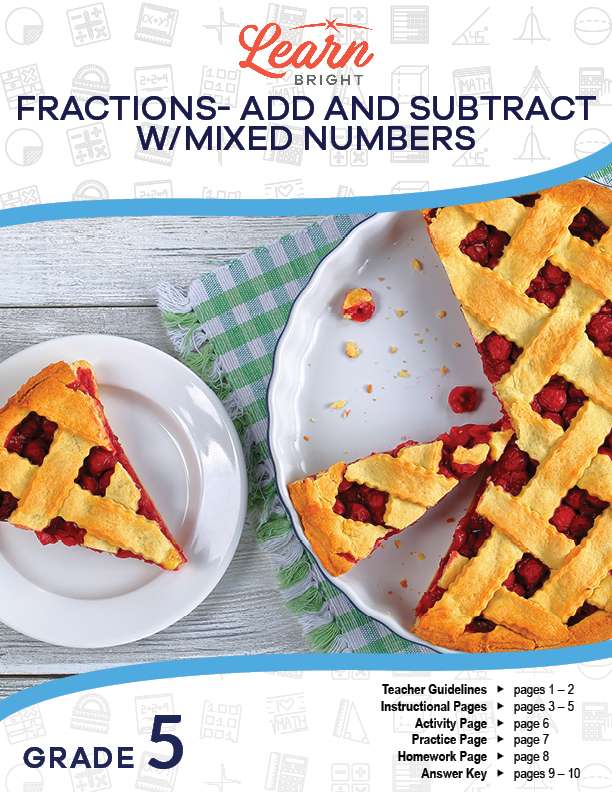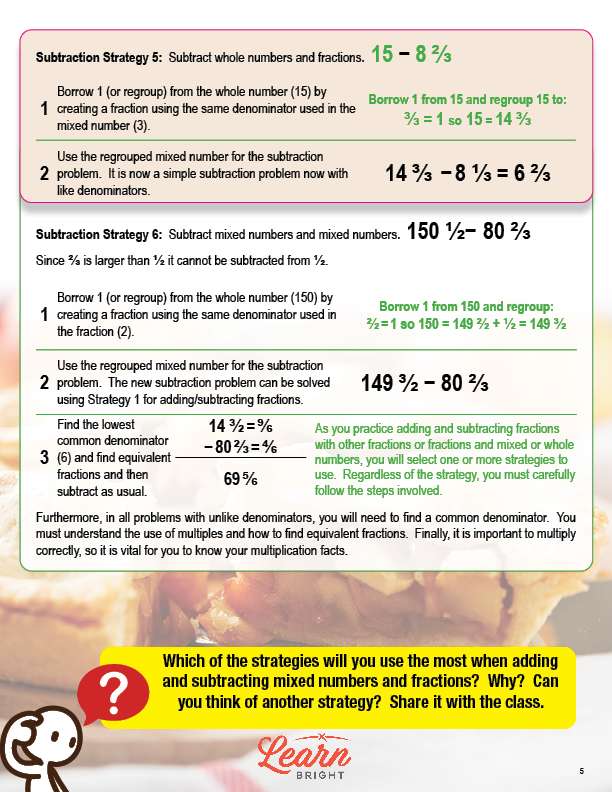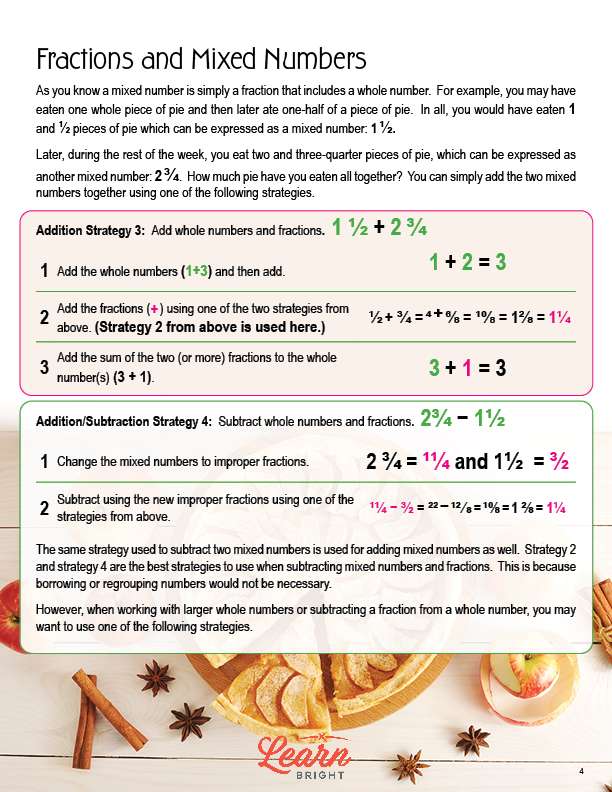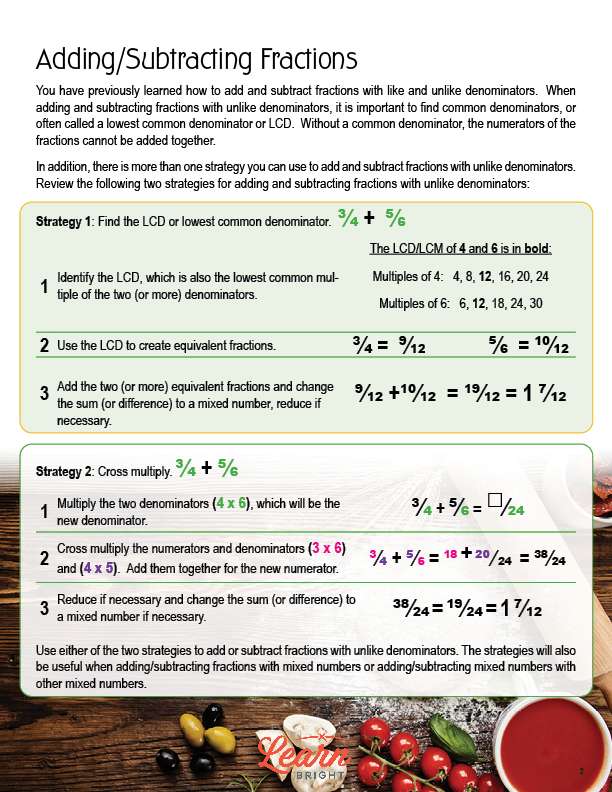Description
What our Fractions—Add and Subtract with Mixed Numbers lesson plan includes
Lesson Objectives and Overview: Fractions—Add and Subtract with Mixed Numbers teaches students methods for adding and subtracting mixed numbers. At the end of the lesson, students will be able to add and subtract fractions with unlike denominators, including mixed numbers. This lesson is for students in 5th grade.
Classroom Procedure
Every lesson plan provides you with a classroom procedure page that outlines a step-by-step guide to follow. You do not have to follow the guide exactly. The guide helps you organize the lesson and details when to hand out worksheets. It also lists information in the blue box that you might find useful. You will find the lesson objectives, state standards, and number of class sessions the lesson should take to complete in this area. In addition, it describes the supplies you will need as well as what and how you need to prepare beforehand. The supplies you will need for this lesson are colored pencils, poster paper, and the handouts. To prepare for this lesson ahead of time, you can pair students for the activity, gather the supplies, and copy the handouts.
Options for Lesson
Included with this lesson is an “Options for Lesson” section that lists a number of suggestions for activities to add to the lesson or substitutions for the ones already in the lesson. One optional addition to the lesson activity is to have students vote for posters in different categories, like best poster, most colorful, and neatest. If you’d like to add another activity to this lesson, you can have students create addition or subtraction problems with mixed numbers to share with their classmates (including an answer key). Finally, your students can use hands-on manipulatives to enhance their understanding of the concept of borrowing or regrouping a whole number.
Teacher Notes
The teacher notes page includes a paragraph with additional guidelines and things to think about as you begin to plan your lesson. It notes that you can use this lesson along with other lessons related to fractions and mixed numbers. This page also includes lines that you can use to add your own notes as you’re preparing for this lesson.
FRACTIONS—ADD AND SUBTRACT WITH MIXED NUMBERS LESSON PLAN CONTENT PAGES
Adding/Subtracting Fractions
The Fractions—Add and Subtract with Mixed Numbers lesson plan includes three content pages. The lesson begins by reminding students that they’ve already learned how to add and subtract fractions with both like and unlike denominators. To do this, you first need to find common denominators (also called a lowest common denominator or LCD). We actually have two main strategies for add and subtracting fractions with unlike denominators.
The first strategy is to find the lowest common denominator. To solve the example problem 3/4 + 5/6 using this method, we first need to identify the LCD. In this case, the LCD is 12. We then use the LCD to create equivalent fractions. 3/4 becomes 9/12 and 5/6 becomes 10/12. The new equation is 9/12 + 10/12. The final step is to add the equivalent fractions and change the sum or difference to a mixed number, reducing if necessary. 9/12 + 10/12 = 19/12 = 1 7/12.
The second strategy is to cross multiply. Using the same example problem, the first step is to multiply the two denominators, which will become the new denominator (4 x 6 = 24). We then cross multiply the numerators and denominators (3 x 6 and 4 x 5). We then add them together to find the new numerator. 3 x 6 = 18 and 4 x 5 = 20. 18 + 20 = 38, so the new fraction is 38/24. Finally, we reduce as needed. 38/24 = 19/12 = 1 7/12.
We can use either of these strategies to add or subtract fractions with unlike denominators. We can also use these strategies when adding or subtracting fractions with mixed numbers or adding or subtracting mixed numbers with other mixed numbers.
Fractions and Mixed Numbers
Next, the lesson discusses how to add and subtract fractions with mixed numbers. A mixed number is a fraction that includes a whole number. The first addition strategy for mixed numbers is to add the whole numbers and fractions separately. The lesson includes an example problem to illustrate this strategy: 1 1/2 + 2 3/4. The first step is to add the whole numbers (1 + 2 = 3). Next, we add the fractions using one of the strategies from the first part of the lesson. In this example, we add 1/2 + 3/4 and end up with 1 1/4. Finally, we add the sum of the fractions to the whole numbers. In this case, we add 3 + 1 = 4. We add the fraction to the whole number for a final sum of 4 1/4.
The next strategy shows how to subtract whole numbers and fractions. The example problem is 2 3/4 – 1 1/2. First, we change the mixed numbers to improper fractions. 2 3/4 becomes 11/4 and 1 1/2 becomes 3/2. Finally, we subtract the improper fractions using one of the strategies that we’ve already learned. The final answer is 1 1/4. This is a good method to use when you don’t have to borrow or regroup numbers. The final two subtraction strategies cover situations in which you have to borrow or regroup.
The next strategy shows another way to subtract whole numbers and fractions, using the example 15 – 8 2/3. The first step is to borrow 1 from the whole number (or regroup), creating a fraction with the same denominator as the mixed number. In this example, we borrow 1 from 15 and regroup. 3/3 = 1, so 15 = 14 3/3. Next, we use the regrouped number to subtract; the problem is now a subtraction problem with like denominators! 14 3/3 – 8 1/3 = 6 2/3.
The final strategy shows a way to subtract mixed numbers from mixed numbers, using the example 150 1/2 – 80 2/3. The first step is to borrow 1 or regroup from the whole number using the same method described previously. 2/2 = 1, so 150 = 149 2/2 + 1/2 = 149 3/2. Next, we use the regrouped number to subtract: 149 3/2 – 80 2/3. We have to find the lowest common denominator (in this problem, it’s 6) and find equivalent fractions. We can then subtract normally! The final answer is 69 5/6.
You can use all of these strategies to add or subtract mixed numbers. The strategy you choose will depend on the problem. One important note is that you have to find a common denominator for all problems with unlike denominators. You must also know how to find equivalent fractions and how to multiply correctly!
FRACTIONS—ADD AND SUBTRACT WITH MIXED NUMBERS LESSON PLAN WORKSHEETS
The Fractions—Add and Subtract with Mixed Numbers lesson plan includes three worksheets: an activity worksheet, a practice worksheet, and a homework assignment. You can refer to the guide on the classroom procedure page to determine when to hand out each worksheet.
POSTER ACTIVITY WORKSHEET
Students will work with a partner to complete the activity worksheet. Each pair of students will create a poster, half of which will show a strategy for adding two mixed numbers, and the other half of which will show a different strategy for subtracting two mixed numbers with regrouping or borrowing. Students will use text, pictures, arrows, labels, and more on their poster. The poster should clearly show someone how to add and subtract mixed numbers. The worksheet includes space that students can use for a rough draft of their poster.
Students can also work either alone or in larger groups for this activity.
SOLVING PROBLEMS PRACTICE WORKSHEET
The practice worksheet asks students to solve 15 problems using one or more of the strategies that they learned during the lesson.
FRACTIONS—ADD AND SUBTRACT WITH MIXED NUMBERS HOMEWORK ASSIGNMENT
For the homework assignment, students will first read, solve, and explain two word problems where they need to add or subtract with mixed numbers. They will also solve three problems that involve mixed numbers.
Worksheet Answer Keys
This lesson plan includes answer keys for the practice worksheet and the homework assignment. If you choose to administer the lesson pages to your students via PDF, you will need to save a new file that omits these pages. Otherwise, you can simply print out the applicable pages and keep these as reference for yourself when grading assignments.









